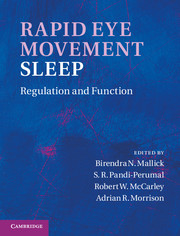Book contents
- Frontmatter
- Contents
- Contributors
- Preface
- Acknowledgments
- Organization
- Section I Historical context
- 1 The sleep–dream state: historic and philosophic perspectives
- 2 REM sleep and dreaming
- 3 REM sleep and dream sleep: are they identical?
- 4 The discovery of REM sleep: the death knell of the passive theory of sleep
- 5 REM sleep and dreaming: the nature of the relationship
- Section II General biology
- Section III Neuronal regulation
- Section IV Neuroanatomy and neurochemistry
- Section V Functional significance
- Section VI Disturbance in the REM sleep-generating mechanism
- Index
- Plate section
- References
1 - The sleep–dream state: historic and philosophic perspectives
from Section I - Historical context
Published online by Cambridge University Press: 07 September 2011
- Frontmatter
- Contents
- Contributors
- Preface
- Acknowledgments
- Organization
- Section I Historical context
- 1 The sleep–dream state: historic and philosophic perspectives
- 2 REM sleep and dreaming
- 3 REM sleep and dream sleep: are they identical?
- 4 The discovery of REM sleep: the death knell of the passive theory of sleep
- 5 REM sleep and dreaming: the nature of the relationship
- Section II General biology
- Section III Neuronal regulation
- Section IV Neuroanatomy and neurochemistry
- Section V Functional significance
- Section VI Disturbance in the REM sleep-generating mechanism
- Index
- Plate section
- References
Summary
Who so regardath dreams is like him that catcheth at a shadow, and followeth after the wind.
Ecclesiasticus 34.2Summary
Dream study is an ancient science dating to at least 6,000 years ago when dreams perceived as messages from gods were written on the clay codas of Mesopotamia. For the Ancient Greeks and Egyptians it was necessary to distinguish between the “true dreams” of kings and priests (potential messages from god) and other “false dreams” reported even by women and children. Several thousand years later, Rene Descartes, focusing on methods of elucidating such “truths,” developed his scientific method while attempting to differentiate dreaming from external reality. At the turn of the twentieth century, Freud developed his psychoanalytic theories of mental functioning from his approach to dream interpretation. In the 1960s, the apparent realization that REM sleep (REMS) was dreaming destroyed 500 years of belief in Cartesian Dualism and led us into this modern age of unitary activation–synthesis theory. If REMS is dreaming, in neuro-scientific actuality, mind equals brain. The literature is replete with such grand theories purporting to explain the dream state, and it is only recently that experimentally testable scientific approaches have been applied to the study of dreaming. Now, most scientists and philosophers accept that research overwhelmingly demonstrates that REMS occurs without dreaming and dreaming without REMS. It is currently unclear as to how much of the highly developed REMS neurocognitive model presented in this book is applicable to the cognitive state of dreaming.
- Type
- Chapter
- Information
- Rapid Eye Movement SleepRegulation and Function, pp. 1 - 7Publisher: Cambridge University PressPrint publication year: 2011
References
- 1
- Cited by



